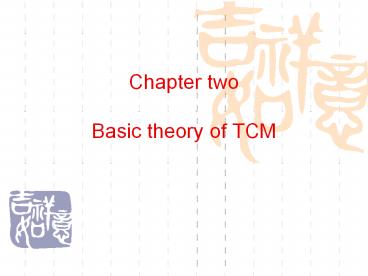Chapter two Basic theory of TCM PowerPoint PPT Presentation
1 / 24
Title: Chapter two Basic theory of TCM
1
Chapter two Basic theory of TCM
2
How is the initiation of TCM?
- From practice and experience
- A long history
- Huangdi Neijing (Huangdis Classic of Internal
Medicine) - The book summarizes the therapeutic experiences
and medical theories of that time period. - One of the classical books
3
The celebrated ancient Chinese doctors
- Hua Tuo
- Late Eastern Han Dynasty
- Mafei San
- His prescriptions were astonishingly effective.
- He had prescribed different medicines to treat
the same illness. - Causes of illness roots internally ,so the
purgative works.
4
- Zhang Zhongjing
- The Chinese medical sage ??
- He specialized in the study of typhoid fever.
- Contagions Contagious typhoid
- The so-called typhoid at that time includes
cholera??, dysentery??, pneumonia??, flu and some
other acute contagious diseases.
5
- A complete system of theories on pathology,
diagnosis, therapy and prescriptions for typhoid
fevers was founded by Zhang Zhongjing. - Treatise on febrile and miscellaneous diseases
6
- Sun Simiao
- One needle saved two lives.( a tale)
- Pregnant woman
- Prescriptions worth a thousand gold for
emergencies - A supplement to prescriptions worth a thousand
gold
7
- Li Shizhen
- A great physician and pharmacologist
- An outline of herbal medicine
- The book, known as a brilliant achievement in TCM
development, but also a momentous contribution to
the worlds medicine and biology.
8
- The essential characteristics of TCM
- The concept of holism
- The human body as an organic whole.
- The human body is composed of a number of
viscera, organs and tissues, which have their own
respective functions. - Every functions is a component of the general
activity, and inter-influence pathologically.
9
- Treatment determination based on syndrome
differentiation - Syndrome differentiation and treatment
determination are inseparable in the process of
diagnosis and treatment of disease, and embody
the combination of theory and practice. - Syndromes differentiation
10
- ????
- Concept of holism/entirety
- Holistic concept
- Holistic philosophy
- ????
- Determination of treatment based in pathogenesis
obtained through differentiation of symptoms and
signs
11
- ????
- treating the same disease with
different therapies
????
treating different diseases with the
same therapy)
12
- ????
- system of meridians and collaterals
- ????
- exterior and interior relationship
13
- ?????????????????????????????
- ????????????,?????
- The concept of holism runs through every aspect
of traditional Chinese medicine including
physiology, pathology, diagnosis, syndrome
differentiation and treatment.
14
- ????,????
- Basic therapeutic principle in TCM is to
reinforce insufficiency/deficiency and
purge/reduce excess.
15
What are yin-yang and the five-element doctrine?
- Yin and yang are two aspects of the unity of
opposite things. - Major concepts of yin-yang theory
- Opposition of yin-yang
- Interdependence of yin-yang
- Wax-wane of yin-yang
- Transformation of yin-yang
16
- ?????
- predominance/ excess of yin leading to disorder
of yang disease
- ????? ?
17
- ????
- predominance of yin leading to heat
syndrome/disorder
- ???? ?
18
- ????
- impairment of yang involving yin
- ?????
?????
19
- ????,????
- Extreme cold generates heat and extreme yin
changes/transforms into yang.
????,?????
Relative balance between yin and yang
20
- Application of yin-yang in TCM
- Yin-yang and the structure of the body
- Yin-yang and the physiological functions of the
body
21
- Yin-yang and pathological changes in the body
- The application of yin-yang in diagnosis of
disease - The application of yin-yang in treatment of
disease
22
- The five-element doctrine
- theory/ doctrine of five elements (five phases
theory) - Wood fire earth metal water
- They are the five indispensable materials in
human life.
23
- Used the theory to explain the whole physical
world. - Inter-promotion inter-restriction
- To explain physiological and pathological changes
in the human body, and the relation of the body
to the external environment.
24
- Characteristics of the five elements
- Five elements zangfu viscera and other organs
Wood Livergall bladder eye tendon anger
Fire heartsmall intestine tongue vessel joy
Earth Spleenstomach mouth muscle thinking
Metal lung Large intestine nose skin sorrow
Water Kidney urinary ear Bone fear

